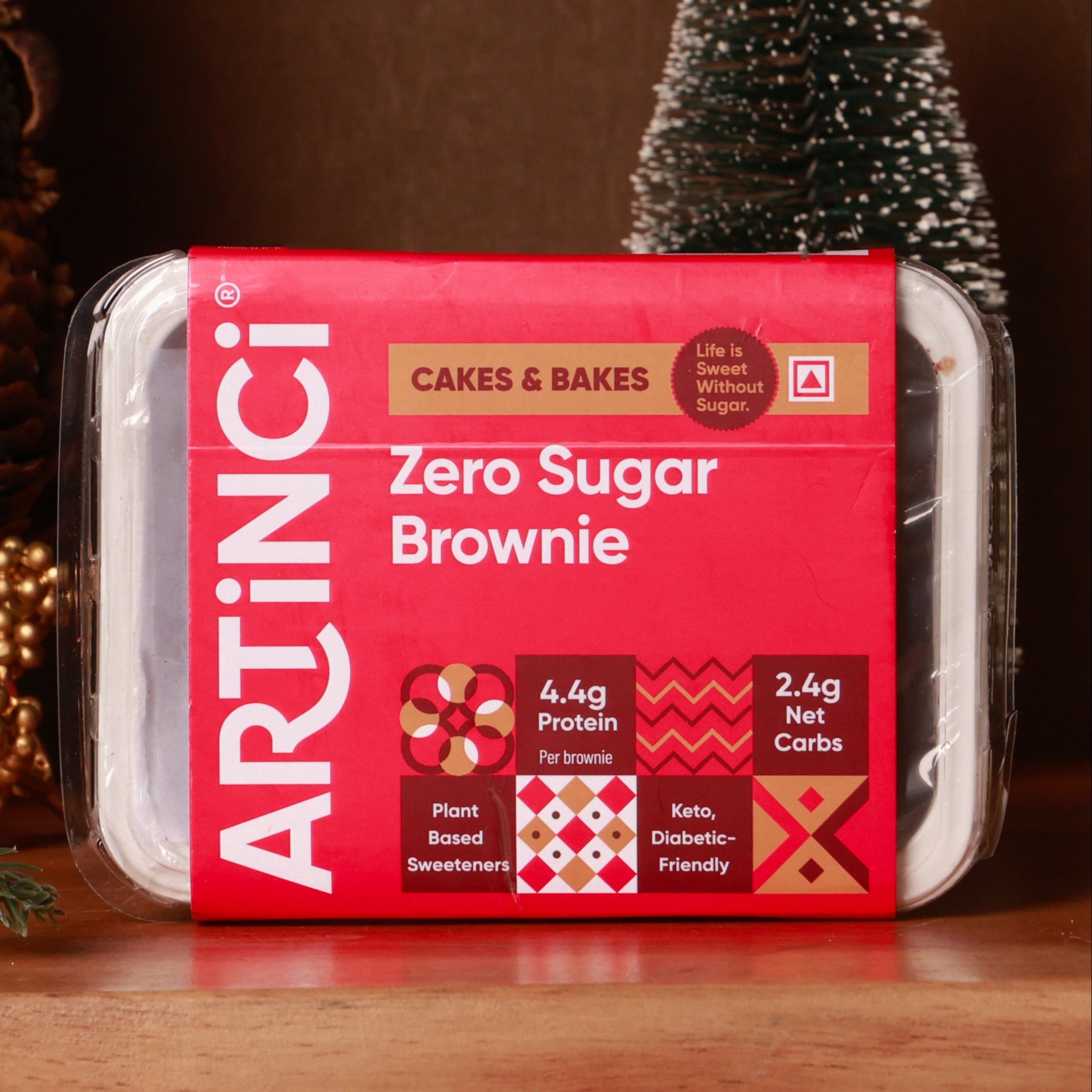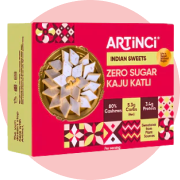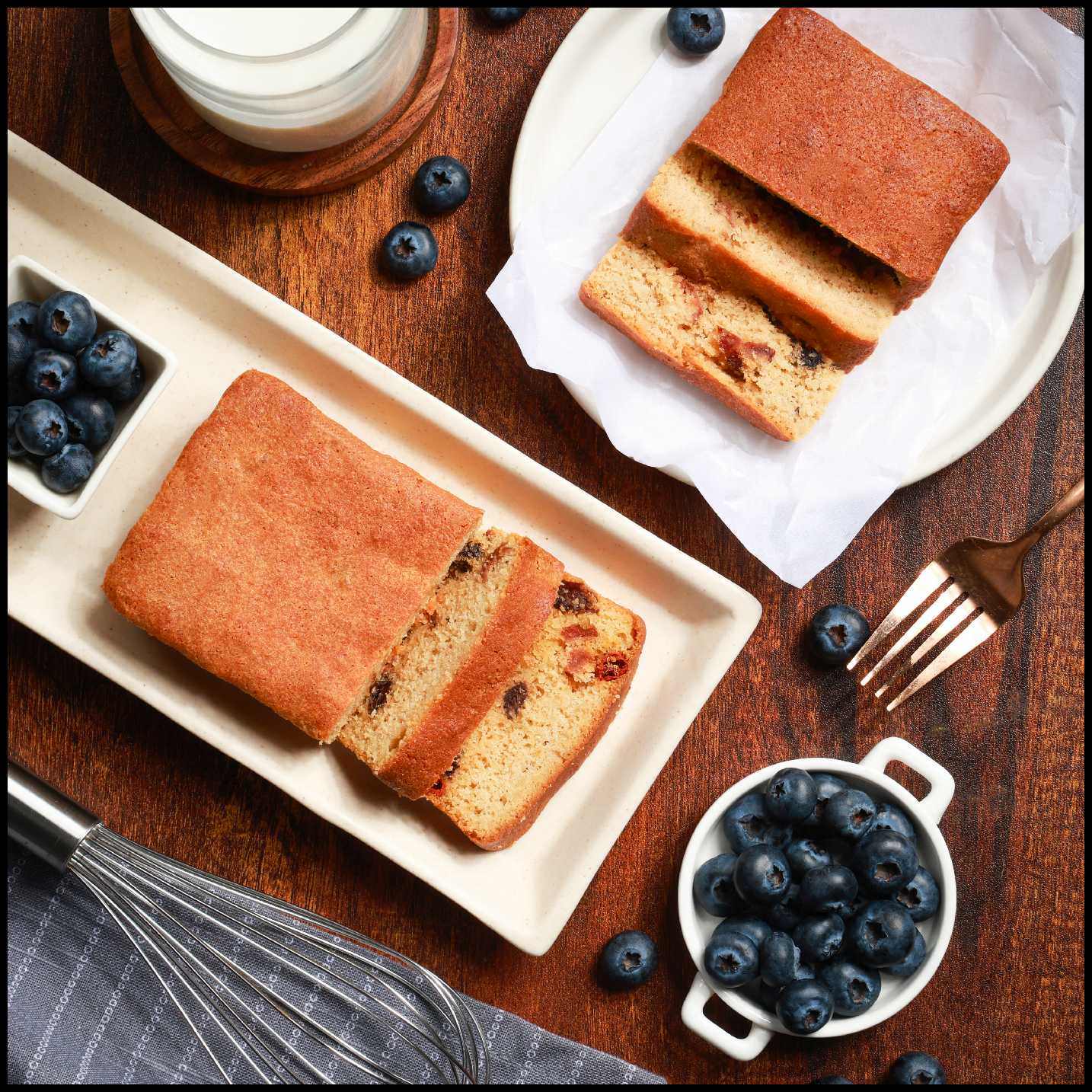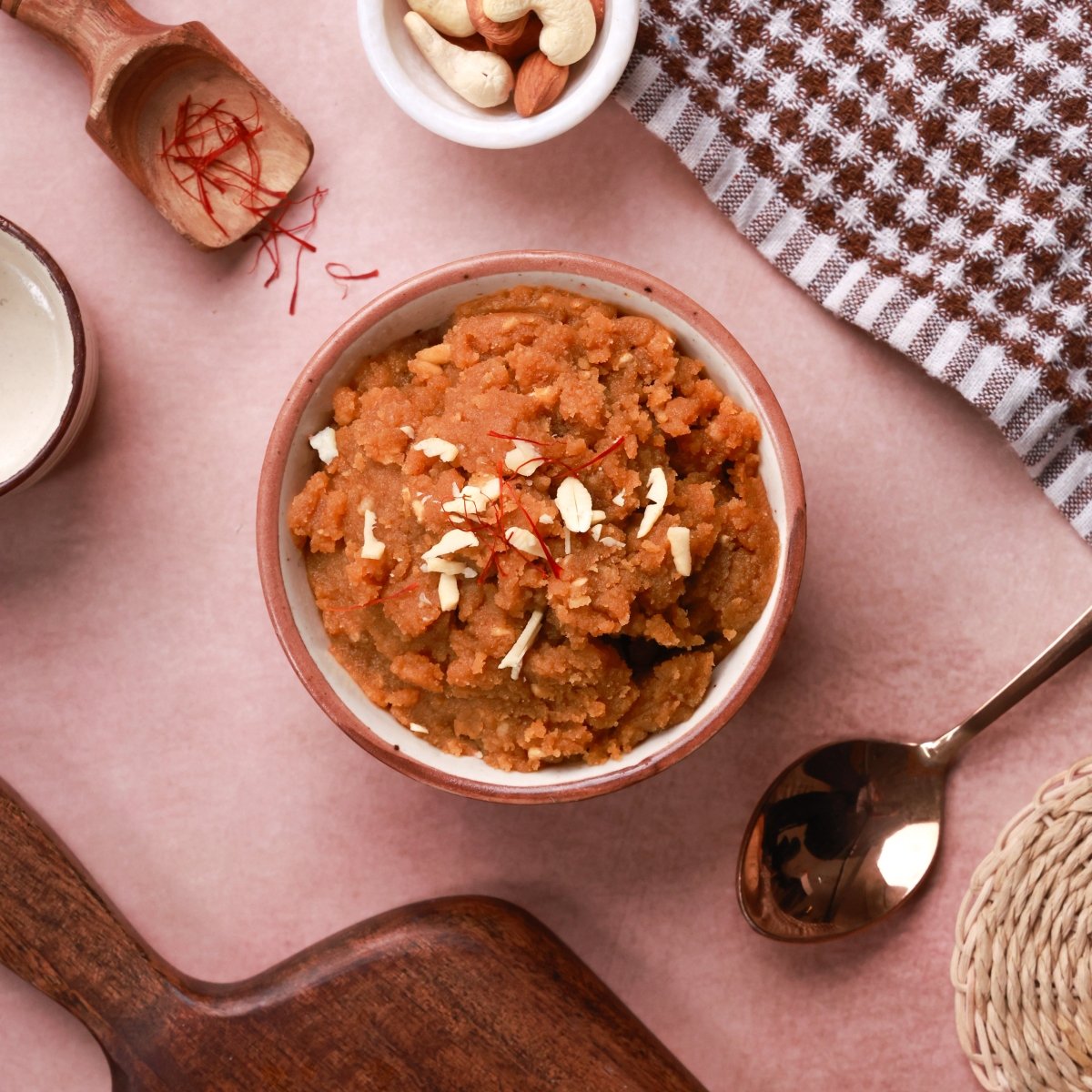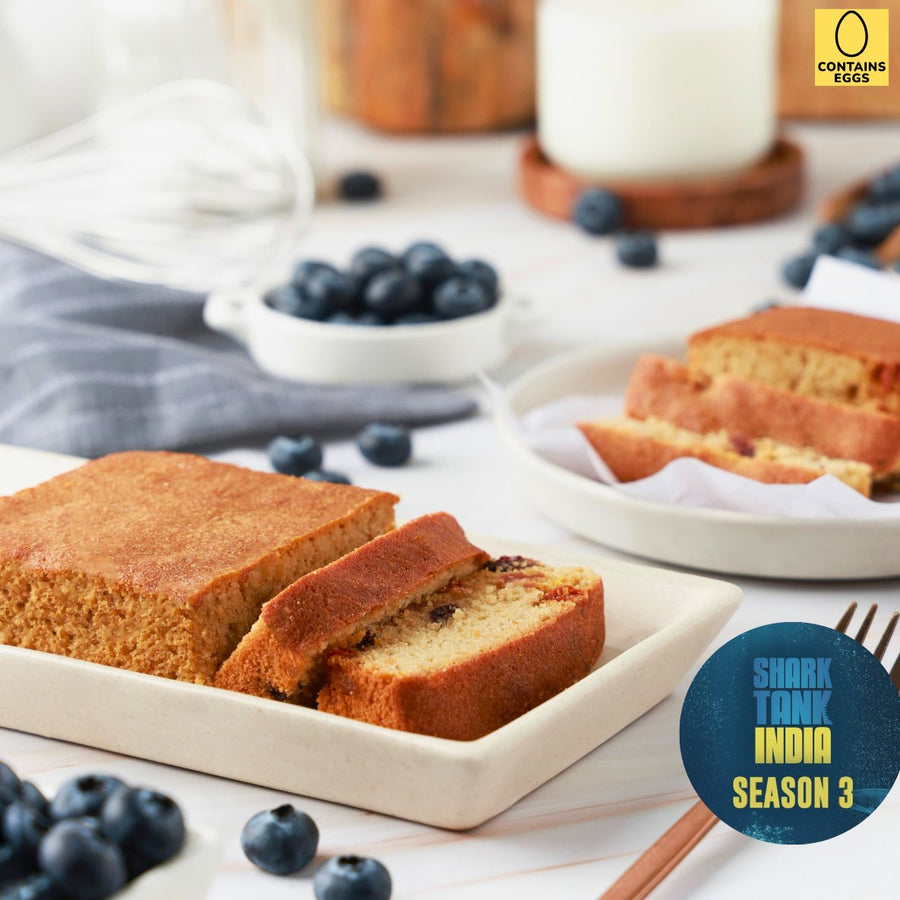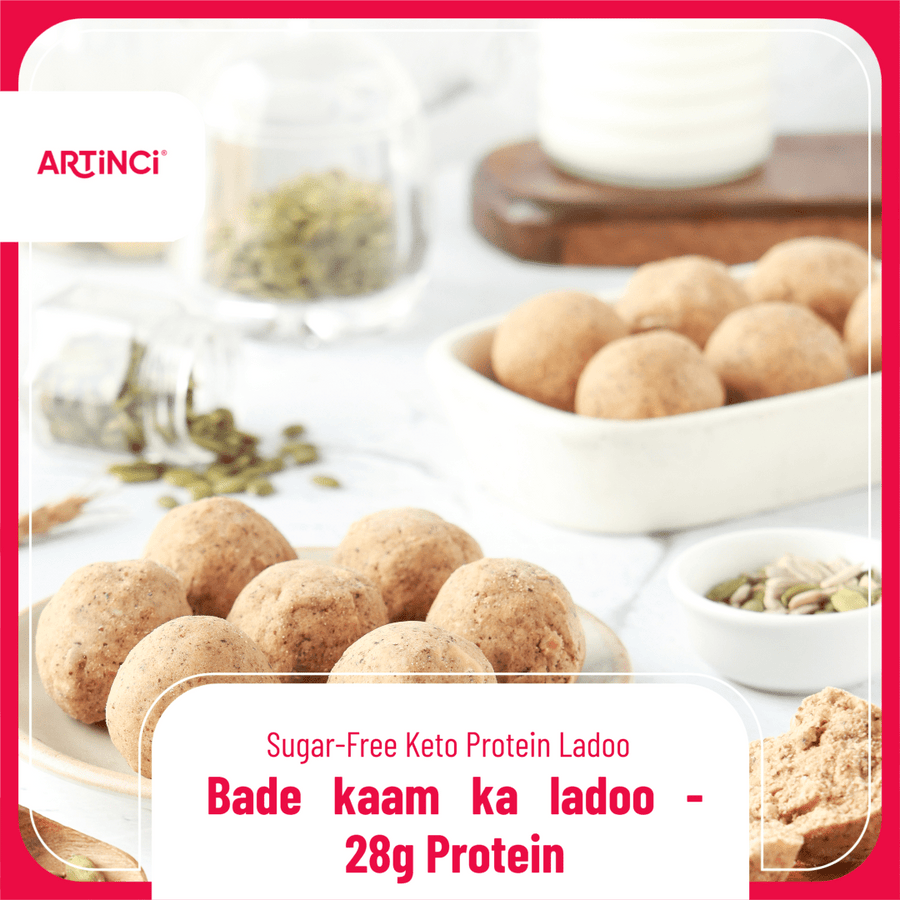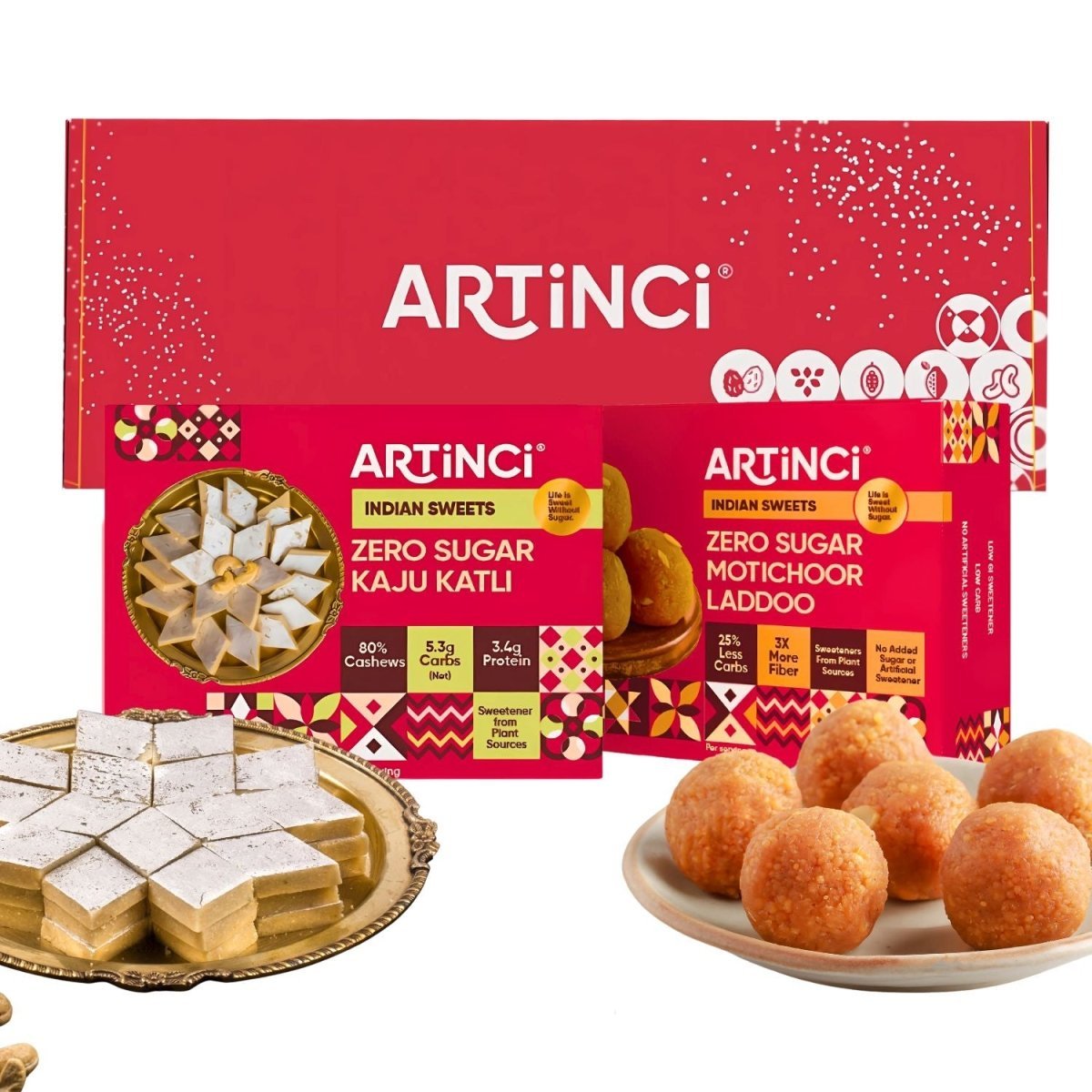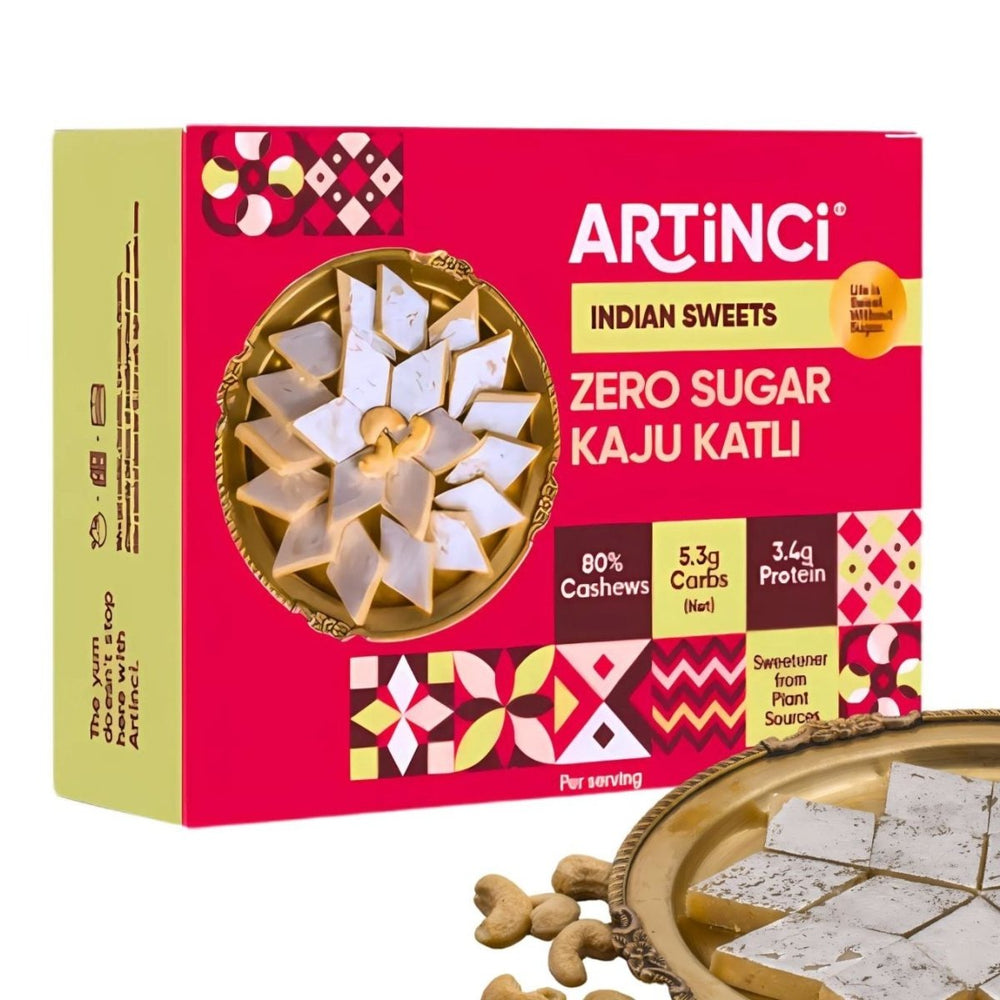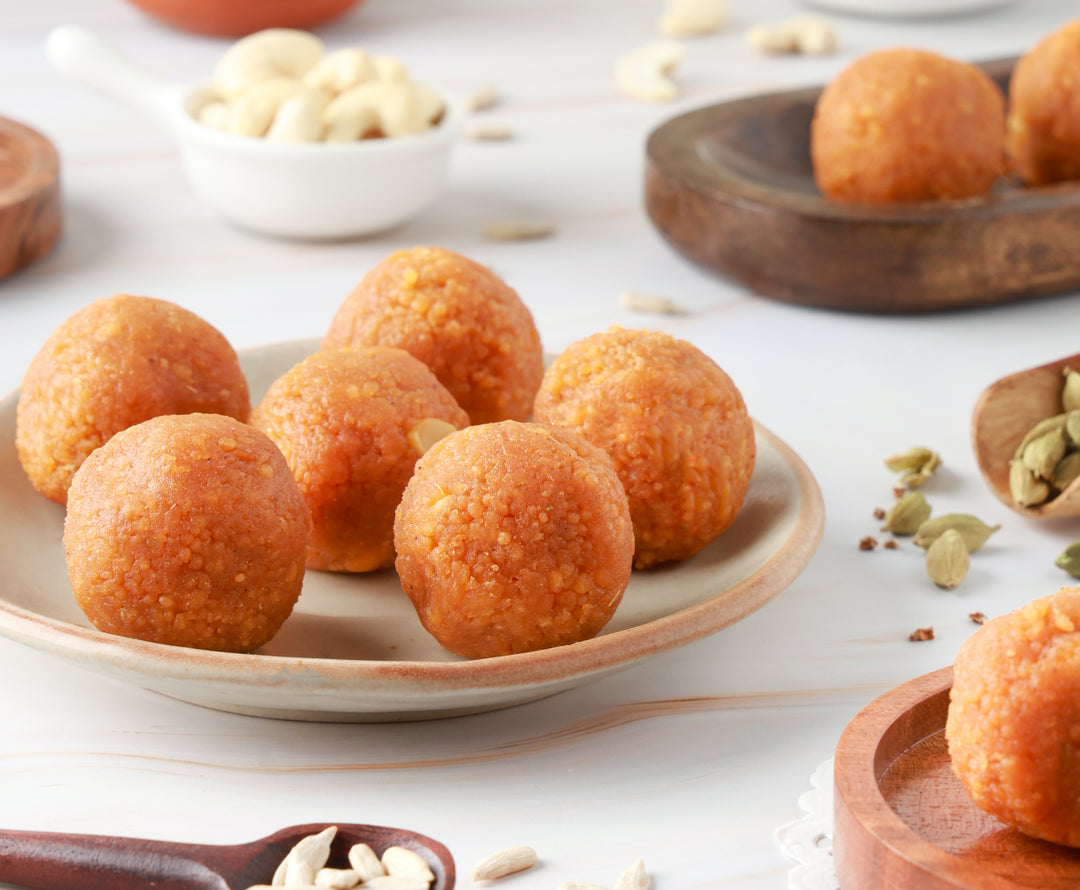Welcome to the world of sugar free joy!
Low Carb Sugar-Free Desserts & Snacks
Artinci was born out of Aarti's and Sumit's (Artinci's founders) abiding love for great-tasting dessert, while helping them stay committed to their health goals as well. As a result, Artinci makes delicious desserts with zero sugar, that are science and evidence-backed.
Aarti and Sumit come from a family of three generations of diabetics. They were themselves diagnosed pre-diabetic in 2012, and right there began a lifelong quest of a healthy, active lifestyle, including healthy swaps in food
Indulgent Halwas & Cozy Cakes


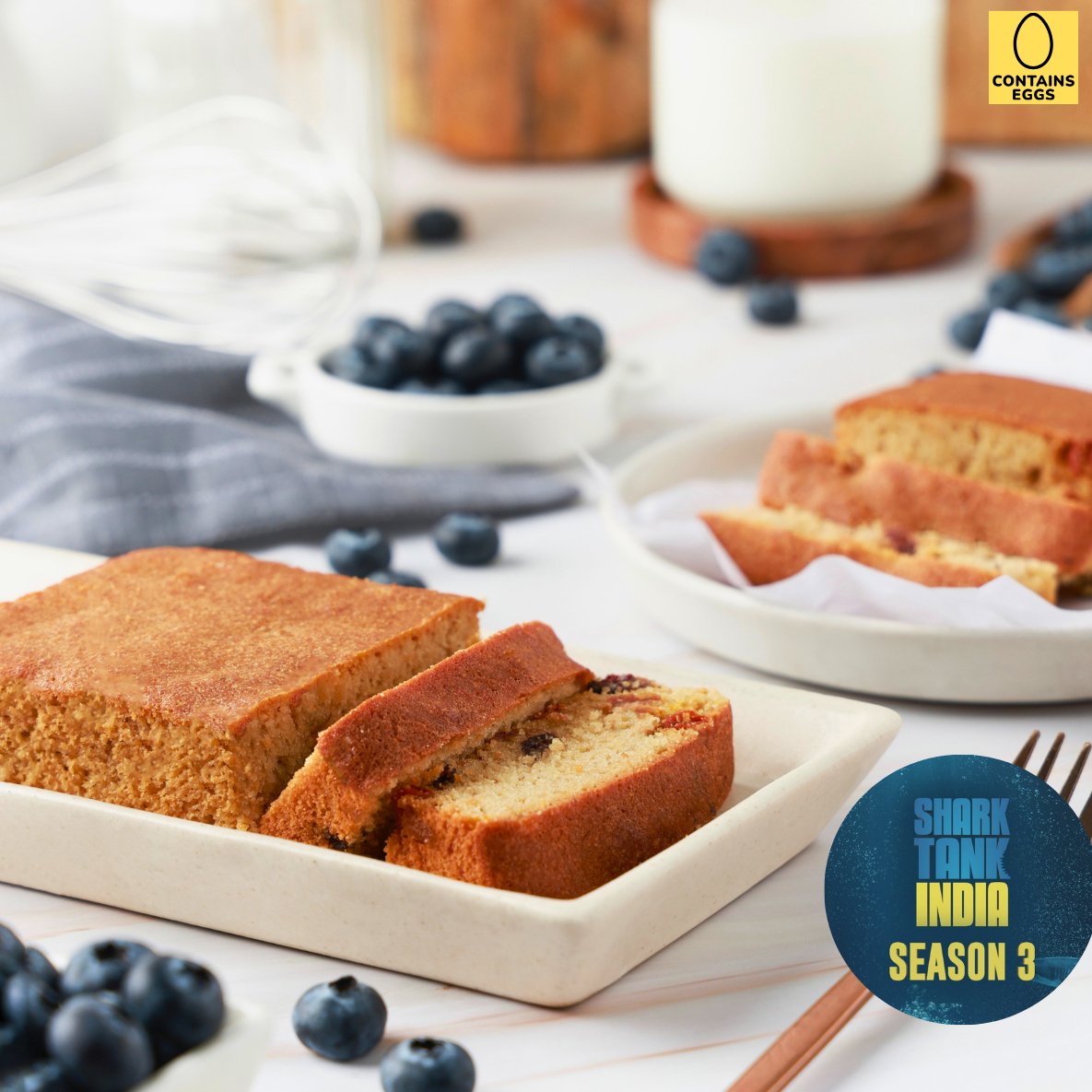


Berries Almond Cake - Made with 100% Almond Flour, Sugar Free, Keto, Gluten Free

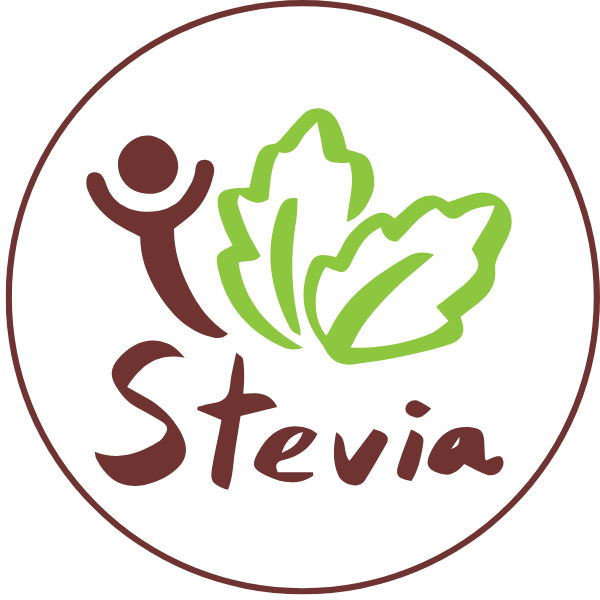

Winter special sugar free halwa combo @499



Aarti Laxman (Founder)
Artinci is founded by Aarti Laxman, a certified Metabolic coach in the Low-Carb Nutrition & Metabolic Health domain from dLife.in, India’s only legally tenable course in this subject—recognized by the NSDC (under the Ministry of Skill Development & Entrepreneurship, Govt. of India). It’s also internationally accredited by the CPD Standards Office UK, with a global record of 144 CPD hours—the highest for any course of its kind. The accreditation is both nationally valid and globally recognised in over 50+ countries..
Festive Gifting in Artinci
Let customers speak for us
All about Sugar and sugar-free

Remember when a candy bar could make you feel on top of the world? As kids, we can't resist sugary treats - it's in our nature and helps us grow. But just like how your taste in music and fashion has changed, your taste buds need to mature too. The good news is that there are plenty of healthy snacks that can satisfy your cravings while also supporting your overall well-being. Your childhood love for sweets won't do you any favors as an adult. Learning to appreciate different flavors leads to discovering nutritious foods and improving your overall health. It's like moving from simple stories to complex novels - there's so much more satisfaction waiting for you. Why Your Taste Needs to Evolve The shift from sugar-loaded treats to savory delights isn't just about following trends or forcing yourself to eat "grown-up" foods. It's about developing a sophisticated palate that appreciates subtle flavors, embraces nutrition, and supports your adult body's needs. As we move beyond the sugar bombs of childhood, we often seek alternatives like erythritol, which offers healthier options without compromising on taste. Healthy snacks—ranging from spiced roasted legumes to roasted makhana and seed mixes—can be both satisfying and nourishing, making it easier to leave behind overly sweet treats. However, it's crucial to understand these substitutes well for informed choices. While we explore these new flavors and healthier options, we also unlock a new level of culinary enjoyment, all while building a foundation for lifelong health. The Biology Behind Childhood Sweet Tooth and Adult Taste Buds Your child's magnetic attraction to sugary treats isn't just a matter of preference - it's hardwired into their biology. Nature designed babies to seek out sweet flavors, starting with the natural sweetness of mother's milk. This innate preference serves a crucial purpose: supporting rapid growth and development through high-energy foods. The science behind taste preferences reveals fascinating differences between children and adults: Energy-Seeking Biology: Children's bodies require significantly more calories per pound than adults, driving their attraction to sweet, calorie-dense foods Taste Bud Density: Kids have about 10,000 taste buds, nearly twice the number found in adult mouths Sensory Perception: Adult taste buds regenerate every 10-14 days, but this regeneration slows with age, reducing sensitivity to both sweet and bitter flavors The TAS2R38 gene, plays a crucial role in how we experience bitter tastes. This gene's protective function is particularly strong in children, making them extra sensitive to bitter flavors - a natural defense mechanism against potentially toxic substances in nature. Your sense of smell also influences taste perception. As you age, this sensory system becomes less acute, affecting how you experience different flavors. This natural decline explains why many adults find themselves gravitating away from intensely sweet foods and developing an appreciation for complex, savory flavors. Interestingly, while the biological aspects of taste may change over time, one thing remains constant: the joy that comes from indulging in sweet treats or healthy snacks. Brands like Artinci offer a range of products rooted in science and designed for optimal taste using the best ingredients. So whether you're looking for high-energy foods for your child or trying to control sugar intake in a diet, Artinci has got you covered. The Role of Experience, Exposure, and Changing Nutritional Needs in Palate Development Your early food experiences create lasting imprints on your taste preferences. Research shows that children exposed to diverse flavors during their formative years develop broader palate preferences as adults. This flavor memory shapes your food choices well into adulthood. Moreover, understanding how taste sensation affects flavor development can provide valuable insights into our evolving palate. Cultural Influences on Taste Preferences Cultural influences play a significant role in developing adult taste preferences. In Asian cultures, bitter foods like bitter melon are introduced early, creating acceptance of complex flavors. European traditions often emphasize savory herbs and aged cheeses, while Latin American cuisines balance sweet, spicy, and umami flavors. Healthy snacks that reflect these diverse culinary traditions can help promote a more sophisticated palate and better nutritional habits. Shifting Nutritional Needs from Childhood to Adulthood Your nutritional needs shift dramatically from childhood to adulthood. Adult metabolism requires: Lower caloric intake Higher protein-to-carbohydrate ratio Increased fiber consumption More micronutrients from diverse food sources These changing requirements naturally guide you toward savory, nutrient-dense foods and healthy snacks. Your body becomes more efficient at processing complex carbohydrates and proteins, making heavily sweetened foods less appealing and less necessary for energy. Embracing Biological Changes for Better Health However, it's important to note that not all sweet foods are created equal. For instance, indulging in sugar-free options can satisfy your sweet tooth without compromising your health. Adults who embrace these biological changes often discover new appreciation for: Fermented foods rich in probiotics Bitter greens packed with antioxidants Complex grain dishes with varied textures Aged foods with developed umami flavors This natural progression toward sophisticated flavors supports optimal health and reflects your body's evolving nutritional wisdom. Interestingly, some traditional sweets can also align with these healthier dietary needs. For example, our Kaju Katli, a popular Indian sweet made from cashews, is sugar-free and diabetic-friendly. Similarly, our Almond Cake, which is keto-friendly and gluten-free, serves as a perfect dessert option for those monitoring their sugar intake. As we adapt to these changes in our palate and nutritional requirements, we can still enjoy the sweetness of life through healthier alternatives. It's all about making informed choices that resonate with our body's evolving needs while still allowing us to indulge every once in a while! Embracing Savory Delights for a Healthier Plate Your mature palate opens doors to a world of sophisticated flavors that nourish both body and soul. Here's a curated selection of savory foods that celebrate your evolved taste buds: Rich, Complex Indian-Inspired Flavours: Dark chocolate (70% cocoa or higher) – perfect as a guilt-free treat Aged cheeses like Amul Gouda or Kalimpong cheese Fermented foods such as homemade achaar, kanji, and idli/dosa batter Roasted peanuts, cashews, and melon seeds spiced with chaat masala Nutrient-Dense Indian Greens: Methi (fenugreek) sautéed with garlic Kale or spinach pakoras air-fried with light besan batter Grilled red amaranth leaves with lemon and salt Saag (mustard greens) lightly seasoned with ajwain and jeera Desi Low-Calorie, High-Satiety Snacks: Roasted chana tossed with curry leaves and masalas Hung curd drizzled with mustard oil and crushed mint leaves Clear vegetable rasam or sambar with mushrooms for umami richness Oven-roasted shakarkandi (sweet potato) wedges with pudina and jeera These foods create satisfying meals without relying on excessive sugar. However, if you're looking for healthy snacks as alternatives to traditional sugary treats, consider exploring the world of sugar-free products. These options are not only healthier but also cater to specific dietary needs like diabetes or weight management. For instance, you could indulge in delicious sugar-free sweets that don't compromise on taste. These sweets are perfect for festive gifting as they include options like Kaju Katli and Motichoor Ladoo. If you’re seeking healthy snacks for special occasions or everyday enjoyment, these treats are a smart pick. Moreover, if you're interested in trying out some guilt-free snacking, our Keto-friendly almond cookies made from 100% almond flour could be the perfect choice. They are not only diabetic-friendly but also gluten-free, making them ideal healthy snacks for anyone aiming to support their wellness goals. Mix and match these ingredients to build nutritious plates that align with your sophisticated palate. Try combining roasted vegetables with whole grains, or create protein-rich salads featuring bitter greens and fermented elements. The possibilities are endless! Tips for Transitioning Your Palate Beyond Sugar Bombs Transform your taste preferences with these practical strategies: Start with familiar flavors: Replace sugary drinks with naturally sweet herbal teas like rooibos or chamomile. Experiment with spice blends: Try za'atar, garam masala, or herbs de Provence to discover new flavor dimensions. Practice mindful seasoning: Use small amounts of sea salt to enhance natural food flavors without overwhelming them. Create flavor combinations: Pair bitter foods with healthy fats - try kale with olive oil or coffee with coconut milk. Explore global cuisines: Sample Mediterranean, Japanese, or Indian dishes that emphasize umami and complex seasonings. For instance, you might enjoy the rich flavors of sugar-free Motichoor Ladoo, a traditional Indian sweet made without added sugar. Read ingredient labels: Choose products with less added sugar to reset your taste expectations. Consider opting for sugar-free options in your diet to aid this transition. Make gradual switches: Replace milk chocolate with 70% dark chocolate, then progress to higher percentages. Try fermented foods: Introduce kimchi, kombucha, or sauerkraut to develop appreciation for tangy flavors. Use natural sweeteners: Swap refined sugar with natural sweeteners like cinnamon, vanilla extract, or fresh fruit in recipes. You could also explore the benefits of zero-sugar sweeteners such as stevia which can be a healthier alternative. Indulge guilt-free: If you're craving something sweet but want to stick to your health goals, consider trying our sugar-free coconut cookies or almond cake, both delicious and diabetic-friendly options. Remember: Your taste buds regenerate every two weeks, making each healthy choice an opportunity to reshape your palate. Conclusion Your evolved palate represents more than just a change in taste preferences—it's a gateway to better health and culinary adventure. Embracing mature flavors opens up a world of nutritious options, including healthy snacks, that nourish both body and mind. The journey from sugar-laden treats to complex, savory delights marks a significant milestone in your relationship with food. Each bite of bitter greens, each sip of unsweetened tea, every exploration of new cuisines, and the choice of healthy snacks all strengthen your commitment to mindful eating. Take pride in your sophisticated taste buds. They're not just helping you make healthier choices—they're guiding you toward a richer, more nuanced experience of food that childhood you never imagined possible. Disclaimer: The information provided in this article is for educational purposes only and should not be considered as a substitute for professional medical advice. It is always recommended to consult with a healthcare professional before making any significant changes to your diet. FAQs 1.Why is it important for adults to evolve their palate beyond childhood sugar bombs? Evolving your palate beyond childhood sugar bombs is essential for embracing complex savory flavors, which supports healthier adult eating habits and contributes to a balanced, nutritious diet. 2.How does the TAS2R38 gene influence children's taste preferences compared to adults? The TAS2R38 gene affects bitter taste perception, making children more sensitive to bitter flavors as a protective mechanism against toxins. This heightened sensitivity diminishes with age, influencing adults' reduced bitterness sensitivity and changing taste preferences. 3.What role do early dietary experiences and cultural influences play in developing adult taste preferences? Early dietary exposure shapes sweet preferences into later childhood and adulthood, while cultural factors influence the inclination towards savory or bitter foods. These experiences combined with changing nutritional needs guide the evolution of an adult's palate. 4.What are some examples of savory foods that appeal to mature palates and support healthy eating? Savory foods like dark chocolate and leafy greens cater to mature palates. Incorporating these along with healthy snacks and low-calorie meals can satisfy evolved taste buds without excess sugar, promoting a healthier plate. 5.What practical tips can help transition your palate away from sugary foods towards more complex flavors? Gradually reducing sugary food and beverage intake while exploring new flavors through herbs, spices, and diverse cuisines can effectively transition your palate beyond sugar bombs toward healthier eating habits.

Did You Know Some 'Healthy' Foods Are Actually Unhealthy?
You're in the grocery store, reaching for that "all-natural" granola bar or "low-fat" yogurt, feeling good about your healthy choice. But here's the surprising truth—these supposedly nutritious foods might actually belong on the list of unhealthy foods. The food industry has become very good at making products look healthier than they actually are. They use things like green packaging and words such as "natural" and "wholesome" to trick us into thinking certain foods are good for us, when in reality, they may be hiding added sugars, excess sodium, or unhealthy fats. Let's take a closer look at these misleading tactics and find out why some so-called "healthy" foods need a second glance. You might be surprised to learn that your favorite salad, smothered in creamy dressing, has more calories than a burger—making it one of those unhealthy foods disguised as a healthy option! The Deceptive Practices Behind Food Marketing Here are some common marketing tactics used by the food industry to make products appear healthier: Misleading Labels: Words like "organic," "whole grain," or "fat-free" can give the impression that a product is healthy, but it's important to read the nutrition label and ingredient list to get the full picture. Portion Distortion: Many packaged foods contain multiple servings per container, which can lead people to underestimate how much they're actually eating. Always check the serving size when evaluating the nutritional content. Hidden Ingredients: Some products may contain added sugars, unhealthy fats, or artificial additives that aren't immediately obvious from the packaging. Look out for ingredients you can't pronounce or recognize. Health Halo Effect: Just because a food is marketed as "healthy" doesn't mean it's automatically good for you. For example, smoothies can be packed with calories and sugar if they're made with sweetened yogurt or fruit juices. Why You Should Be Wary of Certain Foods Here are some reasons why you should be cautious about certain foods that claim to be healthy: High Calorie Content: Some seemingly healthy foods can be surprisingly high in calories. For example, a seemingly innocent salad can turn into a calorie bomb when topped with creamy dressing and fried toppings. Excessive Sugar Levels: Many packaged snacks and beverages labeled as "healthy" can contain significant amounts of added sugars. It's essential to keep an eye on your sugar intake, even from seemingly innocent sources. Unhealthy Fats: Some products may contain trans fats or excessive amounts of saturated fats, which are not beneficial for heart health. Always check the fat content and types of fats used in cooking or processing. While we uncover these truths, it's essential to remember that not all food choices are misleading. Brands like Artinci offer a range of products that align with a genuine health-conscious lifestyle. Moreover, if you're looking for healthier alternatives or just want to indulge in some guilt-free treats, you might want to check out Artinci's sugar free cakes or cookies. These products have been well-received by customers and are known for their quality and taste. Remember though, whether you're buying from a supermarket or an online store like Artinci, always stay informed about what you're consuming. It's the best way to ensure that your food choices truly reflect your health goals. Understanding Health-Washing and the Health Halo Effect What is Health-Washing? Health-washing is a deceptive marketing practice where food companies present products as healthier than they actually are. Think of that granola bar labeled "all-natural" - yet packed with added sugars and preservatives. Companies exploit our desire for better health by using buzzwords like "natural," "pure," or "wholesome" to create an illusion of nutritional value. The Health Halo Effect Explained The health halo effect takes this manipulation deeper - it's the psychological trick where we perceive foods as healthier based on a single positive attribute. A perfect example? That seemingly virtuous salad at your favorite restaurant: Base: Fresh lettuce, tomatoes, cucumbers (genuinely healthy) Toppings: Candied nuts, dried cranberries, crispy wontons Dressing: Honey mustard (2-3 tablespoons = 200-300 calories) Total calories: Often exceeds 800 - comparable to a burger! How Food Packaging Misleads Us Food packaging plays a crucial role in this deception. Companies use: Green color schemes suggesting freshness Images of farms or nature Health-focused terms like "light" or "low-fat" Misleading serving sizes Strategic placement of nutrition claims A "sugar-free" label might hide artificial sweeteners, while low-fat products often compensate with extra sugar. That gluten-free cookie isn't necessarily better for you - it's still a cookie, just made with different ingredients. However, choosing gluten-free almond cookies made with stevia and almond flour are genuinely healthy. Additionally, the increasing popularity of certain food items like gluten-free products has led to a surge in their consumption. However, research indicates that the gluten-free diet may not be beneficial for everyone, particularly for those without celiac disease or gluten intolerance. Common Examples of Misleading "Healthy" Foods Let's uncover some popular "health foods" that might be undermining your wellness goals: 1. Flavored Yogurt These dairy treats often pack more sugar than a candy bar. A single serving can contain up to 30 grams of added sugars, disguised under names like "fruit preparation" or "honey blend." If you're considering alternatives, it's worth exploring the truth about sugar-free substitutes like erythritol, which are a type of sugar substitute. 2. Granola and Trail Mix While nuts and grains are nutritious, commercial varieties often include: Chocolate chips Candied fruits Added oils High amounts of honey or syrup 3. Veggie Chips Don't let the "veggie" fool you. These crispy snacks typically contain: Minimal vegetable content High sodium levels Processed starches Similar calories to regular potato chips 4. Protein Bars Many brands market these as meal replacements, but they're often: Loaded with artificial sweeteners High in saturated fats Packed with processed ingredients Comparable to candy bars in sugar content 5. Smoothie Bowl Bases These Instagram-worthy creations can hide: Sweetened acai puree High-calorie granola toppings Added sugars in fruit purees Excessive portion sizes 6. "Light" Salad Dressings When fat is removed, it's often replaced with: Added sugars Artificial sweeteners Sodium Thickening agents These products show how marketing can turn unhealthy processed foods into perceived health foods through clever packaging and strategic labeling. For example, while indulging in Kaju Katli or Motichoor Ladoo, which are sugar-free and diabetic-friendly, one can still enjoy sweets without compromising on health. The Role of Packaging and Marketing in Shaping Perceptions Food packaging serves as a silent salesperson, using clever design elements to influence our perception of healthiness. Green packaging colors create an illusion of natural, wholesome products. Angular shapes suggest low-calorie options, while rounded packaging implies indulgence. Front-of-pack labels highlight selective nutrients - "high in protein" or "low fat" - distracting from less favorable nutritional aspects. A product labeled "made with whole grains" might contain minimal whole grain content, yet consumers perceive it as a healthy choice. The organic label carries particular weight in consumer decision-making. Research shows shoppers automatically associate organic products with health benefits, regardless of actual nutritional content. A cookie labeled organic isn't necessarily healthier than its conventional counterpart - it still contains sugar, refined flour, and calories. However, not all products labeled as 'healthy' are created equal. It is important to check the other ingredients, look for brands which use natural sweeteners and high quality ingredients. For instance, sugar-free almond flour cakes offer a guilt-free indulgence for those on a weight loss or diabetic-friendly diet. These cakes are keto and gluten-free, sweetened with stevia, making them a healthier option compared to conventional sugary products. It's important to note that packaging and marketing strategies can sometimes mislead consumers about the healthiness of a product. Marketing tactics to watch for include: "Natural" imagery (leaves, farms, earth tones) Health-focused buzzwords ("pure," "simple," "clean") Selective nutrient claims Misleading serving sizes Strategic placement of nutritional information It's crucial for consumers to be aware of these marketing tactics to make informed decisions. For example, indulging in sugar-free coconut cookies, which are diabetic-friendly and made with real coconut, could be a better choice than succumbing to misleadingly labeled products. How Consumer Factors Affect Perceptions of Healthy Food Choices Individual characteristics shape our understanding of what constitutes "healthy" food. A 25-year-old athlete's nutritional needs differ dramatically from those of a 65-year-old with diabetes, yet both might label certain foods as "healthy" based on their personal circumstances. Key factors influencing food perceptions: Age-related needs: Calcium-rich foods might be perceived as healthier by older adults Gender-specific priorities: Iron-rich foods often rank higher in importance for women Metabolic differences: Fast metabolizers might view calorie-dense foods as acceptable Health conditions: Gluten sensitivity drives different "healthy" food choices The challenge of taste expectations creates another barrier. Many consumers associate healthy foods with bland or unpleasant flavors, leading them to avoid nutritious options. This mindset stems from early experiences with poorly prepared healthy meals or the assumption that "if it tastes good, it can't be healthy." However, this doesn't have to be the case. Brands like Artinci are changing the way people think about healthy food by making sure our products are both good for you and tasty. Our sugar-free Motichoor Ladoo, made with pure desi ghee, is a perfect example of how taste and health can go hand in hand. Unpacking Unhealthy Eating Habits Hidden Behind "Healthy" Choices That fresh, crisp salad sitting in front of you might not be as virtuous as you think. Many people unknowingly sabotage their healthy meal choices through seemingly innocent habits: Drowning salads in creamy dressings (2 tablespoons of ranch = 140 calories) Loading up on cheese, croutons, and bacon bits Adding sweetened dried fruits Choosing pre-made salad kits with sugary dressing packets A basic garden salad contains roughly 100 calories. Add generous portions of toppings, and that number can skyrocket to 600+ calories. The same principle applies to other "healthy" foods: Yogurt topped with granola and honey Smoothie bowls covered in chocolate chips Whole grain toast layered with excessive nut butter The Fix: Measure portions of high-calorie toppings, opt for vinegar-based dressings, and load up on fresh vegetables instead. Also, consider replacing sugar-laden sweeteners with healthier alternatives. For instance, zero-sugar sweeteners can be a great option when adding sweetness to your dishes without the extra calories. Moreover, adopting a low-carb diet could also be beneficial in managing your overall calorie intake while still enjoying a variety of foods. The Impact of Food Marketing on Consumption Behavior Food marketing shapes our eating habits in powerful ways we might not realize. Research shows price promotions can increase food purchases by up to 200%, regardless of the food's nutritional value. These marketing tactics create a psychological pull that often overrides our better judgment about healthy eating. Marketing Strategies That Drive Consumption: Buy-one-get-one-free deals encouraging larger portions Strategic product placement at eye level in stores Limited-time offers creating urgency to purchase Health claims prominently displayed on packaging Celebrity endorsements building trust and desire Children face particularly aggressive marketing through: Cartoon characters on packaging Social media influencer partnerships Mobile game advertisements School vending machine placement Television commercials during peak viewing hours The food industry invests billions in sophisticated marketing campaigns that tap into our emotions and desires. A study by the Yale Rudd Center found that companies spend $14 billion annually on food advertising to children alone. These campaigns often promote products high in sugar, salt, and unhealthy fats while using health-focused messaging to mask their true nutritional content. Marketing tactics also create false equivalencies between healthy and unhealthy options. A common example is positioning sugar-laden breakfast cereals next to whole grain options, making them appear equally nutritious through similar packaging and health claims. Making Informed Food Choices: Your Path Forward The journey to truly healthy eating starts with awareness. Marketing claims and health halos can't replace genuine nutritional value. Your food choices deserve a closer look - read labels carefully, question "healthy" claims, and understand what goes into your meals. Here's your action plan for smarter eating: Check nutrition facts - not just the front-of-package claims Question health buzzwords - "natural" doesn't always mean nutritious Consider portion sizes - even healthy foods need moderation Look beyond the packaging - bright colors and wellness imagery can be deceiving It is important to remember a salad loaded with creamy dressing isn't healthier than a balanced meal just because it's "salad." Your health deserves real nutrition, not clever marketing. Trust your knowledge, not the hype. Disclaimer: The information provided is for educational purposes only and should not be taken as medical or professional advice. Always consult with a qualified healthcare professional before making any dietary changes or decisions. FAQs 1.What is health-washing and how does it affect consumer perceptions? Health-washing refers to marketing tactics that manipulate consumer perceptions by presenting products as healthier than they truly are. This includes misleading claims, packaging, and branding that create a false impression of healthiness, causing consumers to believe certain foods are healthy when they may contain unhealthy ingredients. 2.Can you explain the health halo effect with examples? The health halo effect occurs when a food is perceived as healthy based on one attribute, leading consumers to overlook its unhealthy aspects. For example, eating a salad might seem healthy, but if it's drenched in sugary dressings, the overall meal becomes less nutritious. This effect can cause people to underestimate calorie intake or unhealthy components in seemingly 'healthy' foods. 3.Which common foods are often misleadingly marketed as healthy but may be unhealthy? Common examples include processed foods labeled as 'healthy' but high in sugar, salt, or unhealthy fats, such as 'healthy junk food' options. Additionally, salads with excessive sugary dressings or toppings can hide unhealthy elements despite their reputation as nutritious choices. 4.How do packaging and marketing strategies influence perceptions of food healthiness? Packaging elements like color, shape, front-of-pack labels, and organic claims significantly influence consumer trust and perceived healthiness. Marketers use these tactics to create appealing images that suggest a product is healthy even if its nutritional content doesn't support that claim, contributing to health-washing. 5.How can habits like overusing salad dressings effect healthy eating? Overusing salad dressings or toppings can turn an otherwise healthy meal into an unhealthy one by adding excessive sugars, fats, and calories. Such habits contribute to hidden unhealthy eating patterns behind 'healthy' choices like salads and highlight the importance of mindful consumption to maintain nutritional benefits.

You Can't Outrun Your Spoon: Why Exercise Alone Won't Shed Pounds
Ever caught yourself thinking, "I earned this double cheeseburger after my workout"? You're not alone. The belief that you can exercise away poor food choices has become deeply embedded in our fitness culture. Social media feeds overflow with posts about "burning off" last night's pizza or "sweating out" those holiday cookies.But when it comes to a successful weight loss diet, here's the surprising truth: Your 60-minute spin class won't cancel out that morning donut binge. Research shows that relying on exercise alone to maintain a healthy weight is like trying to empty a flooding basement with a teaspoon – it's possible, but wildly inefficient.Let's dive into the science behind why your workout routine, no matter how intense, can't compensate for what's on your plate. The numbers don't lie, and they might just change how you think about that post-workout treat.The Science of Weight ManagementEnergy Balance: The Key to Weight ControlAt its core, weight management comes down to one simple principle: energy balance. This refers to the relationship between the number of calories you consume through food and beverages and the number of calories you burn through physical activity and bodily functions.To lose weight, you need to create a calorie deficit, which means burning more calories than you consume. Conversely, to gain weight, you need to be in a calorie surplus, consuming more calories than you burn. Maintaining your current weight requires a balance between the two.The Role of Exercise in Calorie BurnExercise plays a crucial role in increasing the number of calories you burn each day. It helps boost your metabolism, build muscle mass (which burns more calories at rest), and improve overall fitness levels. However, the amount of calories burned during exercise can vary significantly depending on factors such as intensity, duration, body weight, and type of activity.For example: A 155-pound person burns approximately 260 calories during a 30-minute vigorous cycling session. A 155-pound person burns around 300 calories during an hour-long moderate-intensity yoga class. A 155-pound person burns roughly 400 calories during an hour-long run at a pace of 6 miles per hour. While these numbers may seem impressive, it's important to remember that they only account for the calories burned during exercise itself. They do not consider other factors such as daily activities (walking, cleaning, etc.), basal metabolic rate (the number of calories your body needs at rest), or dietary habits.Why Exercise Alone Isn't EnoughThe problem arises when we rely solely on exercise as our primary means of weight management while neglecting our eating habits. Here's why this approach often falls short: Overestimating Calorie Burn: Many people tend to overestimate the number of calories they burn through exercise. As a result, they may feel justified in indulging in high-calorie foods post-workout or even consuming more calories than they actually burned. Underestimating Food Intake: On the flip side, it's common for individuals to underestimate their food intake or overlook small snacks and bites throughout the day. These seemingly insignificant additions can add up quickly and negate any calorie deficit created by exercise. Compensatory Eating: Some individuals may engage in compensatory eating behaviors after exercising as a way to reward themselves or replenish energy stores. This can lead to consuming more calories than intended and ultimately hindering weight loss efforts. Sedentary Lifestyle Outside of Exercise: While regular workouts are beneficial, if you're leading a predominantly sedentary lifestyle outside of those sessions (e.g., sitting for long periods at work or home), it can counteract the positive effects of exercise on weight management. Rethinking Post-Workout NutritionInstead of indulging in high-calorie foods post-workout, why not opt for healthier alternatives? Here are some options: Kaju Katli - sugar-free and diabetic-friendly Almond cookies - gluten-free and diabetic-friendly Sugar-free coconut cookies - keto-friendly and diabetic-friendly These snacks not only satisfy your cravings but also align with your health goals.Remember, while exercise is important for overall health, it's crucial to make mindful food choices to achieve your weight loss goals.The Calorie Burn Reality CheckLet's break down the math behind exercise and calorie burn - you might be surprised by the numbers.Understanding Your Daily Calorie ExpenditureYour daily calorie expenditure comes from three sources: Basal Metabolic Rate (BMR): 60-75% of calories burned Thermic Effect of Food: 10-15% of calories burned Physical Activity: 10-30% of calories burned The Surprising Truth About Exercise and Weight LossA typical 30-minute run burns 250-400 calories - equivalent to a single chocolate muffin. To lose one pound of fat through exercise alone, you'd need to run nearly 40 miles.How Your Body Adapts to Increased Physical ActivityYour body adapts to increased physical activity by: Reducing energy expenditure during rest periods Becoming more efficient at exercises (burning fewer calories) Lowering spontaneous movement throughout the day The Challenge of Creating a Caloric Deficit Through Exercise AloneA 500-calorie daily deficit needed for sustainable weight loss becomes challenging through exercise alone. You'd need 60-90 minutes of high-intensity workouts every single day - an unsustainable approach for most people.The Role of Diet in Weight LossYour diet plays a crucial role in your weight loss journey - accounting for 70-90% of your results. A well-structured weight loss diet creates the calorie deficit needed to shed pounds effectively.Think of your body as a bank account. The food you eat represents deposits, while your daily activities represent withdrawals. To lose weight, you need to withdraw more than you deposit - and the quality of those deposits matters significantly.A balanced diet plan for weight loss includes: Lean proteins to preserve muscle mass Complex carbohydrates for sustained energy Healthy fats for hormone regulation Fiber-rich foods to control hunger Incorporating sugar-free options like almond cookies into your diet can help maintain this balance. These cookies are not only delicious but also guilt-free, being made with 100% almond flour and sweetened with low GI stevia, making them suitable for a keto-friendly diet.Poor Food Choices Can Undermine Your WorkoutsPoor food choices can quickly erase your workout efforts. A single slice of pizza (300 calories) nullifies 30 minutes of jogging. Strategic meal planning helps you avoid these pitfalls: Pre-portioned meals prevent overeating Low-calorie snacks curb sudden hunger Balanced macronutrients support muscle recovery Regular meal timing stabilizes blood sugar Your workout diet should align with your exercise routine, providing adequate fuel without excess calories. For instance, planning meals around workouts can be beneficial. This includes understanding how smart scales and wearables can assist in managing dietary needs beyond just weight loss.Healthier Sweet OptionsWhen it comes to sweets, opting for sugar-free alternatives can be a game changer. For example, our almond cake is keto-friendly, gluten-free, and sweetened with stevia, making it perfect for those on a weight loss or diabetic-friendly diet.Additionally, during festive seasons, indulging in traditional sweets doesn't have to derail your diet. You can enjoy the delicious taste of India with our sugar-free Motichoor Ladoo, made with pure ghee and no added sugar.By making these strategic dietary choices and aligning them with your fitness routine, you pave the way for sustainable weight loss success. Health Benefits of Exercise Beyond Weight LossRegular physical activity transforms your body far beyond the numbers on your scale. Research shows exercise delivers powerful health benefits that enhance your quality of life: Heart Health: Just 30 minutes of daily moderate exercise strengthens your heart muscle and reduces heart attack risk by up to 35% Blood Pressure Control: Regular workouts help maintain healthy blood pressure levels, reducing strain on your cardiovascular system Mental Wellbeing: Physical activity boosts mood-enhancing endorphins, reduces anxiety, and improves sleep quality Bone Strength: Weight-bearing exercises increase bone density and lower osteoporosis risk Brain Function: Exercise enhances memory, focus, and cognitive performance while reducing dementia risk Disease Prevention: Active individuals show significantly lower rates of: Type 2 diabetes Certain cancers Stroke Depression These benefits emerge regardless of weight changes, making exercise a vital component of your health journey. However, managing certain health conditions like diabetes can be challenging.Additionally, dietary choices significantly impact health outcomes. The rise in popularity of sugar-free products reflects growing health concerns about sugar. Understanding the truth about sugar-free substitutes, like erythritol, can help make informed dietary choices.The Danger of Poor Diet Despite High Activity LevelsResearch reveals a startling truth: high physical activity levels cannot fully protect you from the risks of poor dietary choices. A groundbreaking study published in the British Journal of Sports Medicine found that individuals who maintained intense exercise routines while consuming processed foods and excessive sugars faced: 27% higher risk of cardiovascular disease 21% increased mortality rate 19% greater chance of developing type 2 diabetes The quality of your diet has a significant impact on your health outcomes. Athletes who prioritize nutrient-dense foods experience: Enhanced recovery times Improved immune function Better metabolic health Reduced inflammation markers A recent Harvard study compared two groups of active individuals: those following a Mediterranean-style diet versus those consuming typical Western diets high in processed foods. The Mediterranean diet group showed 31% lower rates of chronic disease development, despite both groups maintaining similar exercise levels.These findings highlight a crucial point: physical activity, while beneficial, can't shield you from the damaging effects of poor nutritional choices. Your body requires proper fuel to function optimally, regardless of how many miles you run or weights you lift.This is where the choice of sweeteners in your diet can play a significant role. For instance, while sugar is known to have detrimental effects on health, stevia could be a healthier alternative for those with dietary restrictions such as diabetes. .Combining Nutrition and Exercise for Optimal ResultsA strategic combination of proper nutrition and physical activity creates a powerful formula for sustainable weight loss. Research shows that people who adopt both dietary changes and regular exercise maintain their weight loss 3-4 times longer than those focusing on just one approach.Here's what an effective combined strategy looks like:Exercise Guidelines 150-300 minutes of moderate-intensity cardio per week 2-3 strength training sessions targeting major muscle groups Active recovery days with light activities like walking or yoga Nutrition Framework Create a modest calorie deficit of 500-750 calories daily Fill your plate with lean proteins, whole grains, fruits, vegetables Track portion sizes using measuring tools or hand-based portions The key lies in making small, sustainable changes in both areas. Start by swapping one processed snack for fruit and adding a 10-minute walk after dinner. Build up gradually - add another healthy swap and increase your walk by 5 minutes each week.Your body responds best to consistent, moderate adjustments rather than extreme changes. Think of it as teaching your body a new normal rather than forcing it through temporary restrictions. Studies show that people who make gradual lifestyle modifications have a 65% higher success rate at maintaining their results long-term.Practical Tips for Sustainable Weight LossCreating effective diet meal plans doesn't require complex calculations or extreme restrictions. Here's your actionable blueprint for sustainable weight management:Smart Meal Planning Strategies: Plan your meals 24 hours in advance Use smaller plates to control portions Fill half your plate with vegetables Include lean protein in every meal Measure cooking oils with a tablespoon Low-Calorie Snacks That Actually Satisfy: Greek yogurt with berries (150 calories) Apple slices with 1 tbsp almond butter (160 calories) Baby carrots with hummus (100 calories) Hard-boiled egg with cherry tomatoes (85 calories) Air-popped popcorn (30 calories per cup) Track your food intake using a smartphone app to stay accountable. Aim for a daily calorie deficit of 500-750 calories for sustainable weight loss. Remember to hydrate - drink water before meals to reduce hunger and improve portion control.In addition, consider reducing your sugar intake by exploring sugar-free products. This can be beneficial for weight loss or managing conditions like diabetes.Furthermore, adopting a low-carb diet could also be a smart strategy for weight management.If you're looking for some guilt-free indulgences, try our Almond Cakes, which are gluten-free, sugar-free, and high in protein - perfect for satisfying cravings while sticking to your health goals.ConclusionThe "outrun your spoon" myth has misled many fitness enthusiasts into believing they can exercise away poor food choices. Science tells a different story. Your body responds to a complex interplay of nutrition and physical activity - neither component works effectively in isolation.Creating lasting change requires a holistic health approach. Think of it this way: exercise builds your body's engine while proper nutrition fuels it for optimal performance. The most successful weight management strategies combine: Smart food choices that nourish your body Regular physical activity that strengthens your systems Sustainable habits you can maintain long-term The path to better health isn't found in endless cardio sessions or restrictive diets. It lies in the balanced integration of mindful eating and purposeful movement - a sustainable approach that transforms not just your body, but your entire relationship with health.Artinci is making strides in the mindful eating area , offering guilt-free indulgences without compromising on taste or nutrition. Our Almond Cakes are just one example of how we prioritize health without sacrificing flavor. By incorporating sugar free products into your diet, you can take a step towards the balanced approach to health that we advocate for. Remember, true well-being is about nourishing your body, nurturing your mind, and cherishing your relationship with food. So why not make a conscious choice to embrace a holistic approach to health and start your journey with Artinci today?Disclaimer: The information provided in this article is for educational purposes only and should not be considered as medical advice. Please consult with a healthcare professional or registered dietitian before making any changes to your diet or exercise routine.FAQs 1.Can workouts cancel out the effects of unhealthy eating?No, workouts alone cannot cancel out unhealthy eating habits. Exercise typically accounts for only 10-30% of daily calorie burn, making it challenging to create a significant calorie deficit through exercise alone. Poor diet can negate exercise benefits and hinder weight loss progress.2.Why is diet quality crucial for weight loss?Diet quality plays a critical role in achieving and maintaining weight loss. Consuming balanced meal plans and low-calorie snacks helps create a calorie deficit and supports overall health. Unhealthy eating can offset the positive effects of workouts and stall weight loss efforts.3.What are compensatory behaviors after exercise that affect weight loss?Compensatory behaviors include increased hunger and extra food intake following exercise sessions. Additionally, physiological adaptations may conserve energy, making it harder to lose weight by relying solely on workouts without dietary changes.4.Besides weight loss, what are the health benefits of regular exercise?Regular physical activity offers numerous health benefits beyond shedding pounds, such as lowering blood pressure and reducing risks of chronic diseases like diabetes, stroke, and heart attack. Exercise contributes significantly to overall well-being regardless of weight changes.5.Is it possible to maintain good health with a poor diet but high physical activity levels?Research indicates that poor diets increase chronic disease and mortality risks even among highly active individuals. Combining a high-quality diet with regular exercise yields better health outcomes than relying on physical activity alone while consuming an unhealthy diet.

10 Sugar-Free Fruits That Will Keep Your Diet on Track
Are you craving the natural sweetness of fruits while keeping your sugar intake in check? You're not alone. Millions of health-conscious individuals search for ways to satisfy their sweet tooth without compromising their dietary goals.This guide unveils 10 naturally low-sugar fruits that deliver essential nutrients without spiking your blood sugar levels. These fruits contain minimal natural sugars while offering maximum nutritional benefits.What makes a fruit "sugar-free" or "low-sugar"? These fruits typically contain: Less than 10g of sugar per serving A low glycemic index rating High fiber content to slow sugar absorption Managing sugar intake plays a vital role in: Weight management Blood sugar control Reduced inflammation Better dental health These carefully selected fruits pack powerful health benefits: Rich in antioxidants High in essential vitamins Loaded with dietary fiber Natural immune system boosters Additionally, if you're looking for alternatives to traditional sweeteners, consider exploring the truth about erythritol as a sugar substitute. It's essential to make informed choices when it comes to sweeteners, especially for those managing diabetes. For instance, jaggery is often thought of as a healthier alternative, but it's crucial to understand its effects on blood sugar levels.In case you're interested in indulging your sweet tooth guilt-free, you might want to try our Kaju Katli which is sugar-free and diabetic-friendly, making it the perfect keto-friendly option.Let's explore these nutritious fruits that keep your diet on track while satisfying your fruit cravings.Understanding Natural Sugars in FruitsFruits contain natural sugars called fructose, a type of carbohydrate your body uses for energy. Unlike processed foods with added sugars, fruits package their sweetness with essential nutrients, fiber, and water.The key difference lies in how your body processes these sugars: Natural fruit sugars: Release slowly into your bloodstream, accompanied by fiber Added sugars: Spike blood sugar quickly, offering minimal nutritional benefits A fruit's sugar content depends on several factors: Growing conditions Ripeness level Variety of fruit Climate conditions The glycemic index (GI) measures how quickly foods raise blood sugar levels. The glycemic load (GL) considers both the GI and portion size. Fruits with lower GI and GL values: Digest more slowly Provide steady energy Help maintain stable blood sugar levels Some fruits naturally contain less sugar due to their: Higher water content Higher fiber concentration Genetic composition Growth patterns If you're looking for delicious options that align with these dietary needs, consider exploring some of our best-selling products which include a range of cakes, cookies, chocolates and more. Lastly, don't forget to share your experiences and refer a friend to enjoy these delightful treats too!Benefits of Including Sugar-Free and Low-Sugar Fruits in Your DietLow-sugar fruits pack a powerful nutritional punch while keeping your blood sugar levels stable. These fruits serve as essential components of diabetic-friendly diets, offering natural sweetness without dramatic glucose spikes.Key Health Benefits: Blood Sugar Management: The lower sugar content combined with high fiber helps maintain steady glucose levels. For instance, incorporating more sugar-free products into your diet can further assist in managing your sugar intake. Weight Control: Lower calorie density supports healthy weight management goals Digestive Health: High fiber content aids digestion and promotes gut health. This is particularly beneficial during periods like Ramadan when dietary changes are common. Nutrient Density: Rich in- Essential vitamins (A, C, E) Minerals (potassium, magnesium) Antioxidants (flavonoids, polyphenols) Dietary fiber These fruits allow you to enjoy nature's sweetness while maintaining a balanced, health-conscious diet. Their high water content and fiber make them filling options for snacks and meals, supporting both nutrition goals and appetite control.Top 10 Sugar-Free or Low-Sugar Fruits to Keep Your Diet on TrackSelecting the right fruits can make a significant difference in managing your sugar intake. Here's a curated list of naturally sugar-free and low-sugar fruits that pack a nutritional punch without compromising your health goals.These fruits stand out for their minimal sugar content while delivering essential nutrients your body needs. Each selection has been carefully chosen based on its glycemic impact and nutritional profile.1. Guava (Amrood) Guava emerges as a powerhouse of nutrition with remarkably low sugar content. A single serving (100g) contains: Sugar Content: 8.9g per 100g Fiber: 5.4g per 100g Net Carbs: 3.5g per 100g This tropical fruit excels in blood sugar management through its: High fiber content that slows sugar absorption Rich pectin levels supporting digestive health Low glycemic index rating of 19 Guava's impressive nutrient density includes: 4x more vitamin C than oranges High levels of lycopene Substantial potassium content The fruit's natural compounds help regulate blood sugar levels, making it an excellent choice for people monitoring their sugar intake. Its unique combination of fiber and nutrients creates a satisfying eating experience without the sugar spike common in other fruits.2. Avocado (Butter Fruit)Avocados are a unique fruit with very low sugar content, containing just 1 gram of sugar per whole fruit. This creamy, nutrient-packed fruit offers: 15 grams of heart-healthy monounsaturated fats 9 grams of fiber per fruit Essential vitamins E, K, and B-complex The combination of healthy fats and fiber in avocados helps you feel full and keeps your blood sugar levels stable. Here are some delicious ways to enjoy avocados: Spread on whole-grain toast Blended into smoothies Diced in salads Mashed into guacamole Avocados are good for your heart too! They have the right balance of omega-3 and omega-6 fatty acids. The natural plant sterols found in avocados can help lower cholesterol levels, making them a great choice for heart health.3. Papaya - Moderate Sugar Digestive Fruit BenefitsPapaya stands out as a digestive powerhouse with its moderate sugar content of 8g per 100g serving. This tropical fruit contains papain, a natural enzyme that aids protein breakdown and supports healthy digestion.The fruit's nutrient profile includes: Vitamin C: 88% of daily value per serving Vitamin A: 33% of daily value per serving Fiber: 2.5g per 100g serving Potassium: Essential for heart health The ripe fruit's natural sweetness comes balanced with a glycemic index of 60, making it suitable for controlled portions in low-sugar diets. Its soft texture and easy digestibility make papaya an excellent breakfast choice or post-meal digestive aid.Raw papaya offers even lower sugar content, perfect for those strictly monitoring their sugar intake. You can enjoy it in salads or as a meat tenderizer.4. Indian Gooseberry (Amla) - A Nutrient Powerhouse with Low SugarIndian Gooseberry, also known as Amla, is a highly nutritious fruit that contains very little sugar - only 2.4g per 100g serving. Despite its tart taste, Amla is packed with vitamin C, providing 20 times more than oranges.The antioxidant properties of Amla come from its high content of polyphenols: Gallic acid - fights free radicals Ellagic acid - supports cellular health Emblicanin A & B - unique compounds exclusive to Amla You can include Amla in your diet in various ways: Fresh fruit consumption Dried powder form Amla juice Traditional supplements The natural compounds found in Amla promote liver function, strengthen the immune system, and help regulate blood sugar levels. Its bitter-sour taste makes it a great addition to sugar-free diets, especially for individuals with diabetes or those following low-sugar eating plans.5. Tomato (Technically a Fruit)Tomatoes are a unique addition to the list of sugar-free fruits, containing just 5g of natural sugars per serving. These versatile fruits are packed with nutrients, especially lycopene, a powerful antioxidant known for its benefits in heart health and cancer prevention.Key Nutritional Benefits: High in Vitamin C (40% of daily value per serving) Rich source of potassium Contains beneficial compounds like beta-carotene Only 22 calories per medium tomato The culinary uses of tomatoes make them an excellent choice for low-sugar diets. You can enjoy them: Raw in salads Cooked in curries Blended into smoothies Grilled as a side dish For maximum nutritional benefits, consume tomatoes with a small amount of healthy fat, as this enhances lycopene absorption in your body. 6. Lemon/Lime (Nimbu) - No Sugar Citrus Fruits with Vitamin C BenefitsLemons and limes are unique among fruits because they contain no sugar. Each fruit has only 1-2 grams of sugar. These citrus fruits are also an excellent source of vitamin C, with one lemon providing 51% of your daily requirement.The versatility of these fruits makes them invaluable for health-conscious individuals: Zero-calorie flavor enhancer: Add zest to water, tea, or dishes without sugar impact Natural preservative: Prevents browning in cut fruits and vegetables Digestive aid: Supports healthy digestion and liver function Hydration booster: Creates refreshing beverages without added sugars You can maximize lemon benefits by: Squeezing fresh juice into warm water for morning detox Using as a salt substitute in cooking Adding to salad dressings instead of high-sugar alternatives Incorporating into marinades for meat and fish These citrus fruits are essential for anyone following a sugar-conscious lifestyle, offering robust flavor without compromising dietary goals. Additionally, their health benefits extend beyond just being low in sugar and high in vitamin C.7. Jamun (Indian Blackberry) - Jamun Diabetic Fruit Jamun BenefitsJamun stands out as a powerful ally for blood sugar management. This purple-black fruit contains jamboline - a bioactive compound that helps regulate blood glucose levels. With a remarkably low glycemic index of 25, Jamun prevents sudden spikes in blood sugar levels.The fruit's benefits extend beyond its anti-diabetic properties: Contains natural insulin-like compounds Rich in anthocyanins that combat free radicals Provides essential minerals like iron and potassium Offers just 3-4g of sugar per 100g serving Traditional Ayurvedic medicine has long recognized Jamun's ability to support pancreatic function. The seeds, bark, and fruit pulp work together to enhance insulin production and improve glucose tolerance. You'll find Jamun particularly abundant during the monsoon season across India, making it an accessible choice for your low-sugar fruit selection.To complement the health benefits of Jamun, consider incorporating other low-glycemic food options into your diet. For instance, Keto-friendly almond cookies made with 100% almond flour and sweetened with low GI stevia can be a great addition. 8. Coconut (Tender Coconut Flesh) - Coconut Low Sugar Tender Coconut Nutrition BenefitsTender coconut flesh is a naturally sweet fruit option that is low in sugar. It contains only 3.7 grams of natural sugars per 100-gram serving, making it a great choice for those watching their sugar intake.Key nutritional benefits: Contains healthy fats called medium-chain triglycerides (MCTs) Provides important electrolytes like potassium and magnesium Offers 2.6 grams of dietary fiber per serving Contains minerals such as iron, zinc, and phosphorus The soft and jelly-like texture of tender coconut flesh makes it enjoyable to eat while also providing essential nutrients. Its natural electrolyte content helps maintain hydration, which is especially beneficial in hot weather or after exercise.You can enjoy tender coconut flesh: Raw, straight from the coconut Blended into smoothies Added to fruit salads Mixed into yogurt bowls In addition to its fresh form, coconut can also be enjoyed in other ways. For example, you can try sugar-free coconut cookies that are made with real coconut and are suitable for diabetics. These keto-friendly snacks are sweetened with a natural stevia blend that has a low glycemic index, making them an ideal choice for those who want to limit their sugar consumption.9. Watermelon (In Moderation)Watermelon stands out as a refreshing choice for health-conscious individuals with its impressive 92% water content. A single cup serving contains less than 10g of natural sugars - making it a smart choice for those monitoring their sugar intake.Key nutritional benefits: Rich in lycopene and vitamin C Contains L-citrulline for muscle recovery Natural electrolytes for hydration Only 46 calories per cup The high water content helps you feel full while consuming fewer calories. You'll get maximum benefits by eating watermelon in the morning or as a pre-workout snack. The natural electrolytes support hydration during hot weather or intense physical activity.Portion control tip: Stick to 1-2 cups per serving to maintain blood sugar balance while enjoying its sweet, refreshing taste.10. StrawberriesStrawberries are a delicious low-sugar option, with only 5-7g of natural sugars per cup. These bright red berries are packed with nutrients, especially vitamin C - one serving provides 85% of your daily requirement.Strawberries contain beneficial compounds called polyphenols and anthocyanins, which may help: Protect against heart disease Improve brain function Reduce inflammation Regulate blood sugar levels Support skin health The fiber in strawberries (3g per cup) helps slow down sugar absorption, making them a great choice for managing blood sugar levels. There are many ways to enjoy strawberries: Mixed into plain yogurt Blended in smoothies Added to overnight oats Eaten fresh as a snack Paired with nuts for a balanced treat Whether fresh or frozen, strawberries retain their nutritional benefits, making them a convenient option for health-conscious individuals all year round.Important Considerations When Choosing Fruits for Low-Sugar DietsSelecting the right fruits for a low-sugar diet requires attention to several key factors:Portion Control Matters Track serving sizes to manage total sugar intake Use measuring cups or kitchen scales for accuracy Remember that natural sugars still count toward daily limits Best Times for Consumption Eat fruits earlier in the day Pair with protein or healthy fats to slow sugar absorption Space fruit servings throughout the day Shopping and Storage Tips Choose fruits at peak ripeness Avoid pre-cut fruits with added preservatives Store properly to maintain nutritional value Watch Out For Hidden sugars in dried fruits Fruit juices - stick to whole fruits Canned fruits in syrup Smart Combinations Mix low-sugar fruits with protein-rich yogurt Add to salads for natural sweetness Blend with leafy greens in smoothies Remember: No fruit is completely sugar-free, but these mindful choices help maintain balanced blood sugar levels while enjoying nature's sweetness.FAQs 1.What are sugar-free and low-sugar fruits, and why are they important in managing sugar intake?Sugar-free and low-sugar fruits contain minimal natural sugars (fructose), making them ideal for those looking to reduce sugar intake. Managing sugar consumption is crucial for maintaining healthy blood sugar levels, supporting weight management, and promoting overall health.2.How do natural sugars in fruits differ from added sugars, and why does it matter?Natural sugars like fructose occur naturally in fruits, whereas added sugars are incorporated during processing. Natural sugars come with fiber, vitamins, and antioxidants that aid digestion and provide health benefits, while added sugars can lead to spikes in blood sugar and negative health effects.3.Which fruits are naturally low in sugar or sugar-free and beneficial for a low-sugar diet?Some naturally low-sugar or sugar-free fruits include guava, avocado, papaya, Indian gooseberry (amla), tomato, lemon/lime (nimbu), jamun (Indian blackberry), tender coconut flesh, watermelon (in moderation), and strawberries. These fruits offer essential nutrients while keeping sugar intake low.4.What are the health benefits of including sugar-free or low-sugar fruits in my diet?Including these fruits supports diabetic-friendly diets, aids blood sugar control, contributes to weight management and digestion, and provides a rich source of vitamins, minerals, fiber, and antioxidants without the high sugar impact.4.How does the glycemic index affect fruit selection for blood sugar management?The glycemic index (GI) measures how quickly foods raise blood glucose levels. Fruits with a low GI have less impact on blood sugar. Choosing low-GI fruits like guava, jamun, and avocado helps maintain stable blood sugar levels.






